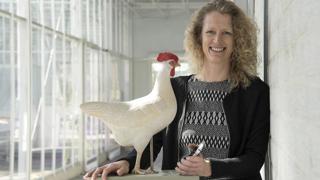
Lenny van Erp - van der Kooij PhD
Professor Animal Welfare and Technology
- L.vErp@has.nl
- L.vErp@has.nl

The Precision Livestock Farming professorship wants to facilitate smart farming and the use data for more precise operational management. The research group also looks to other industries for inspiration.
The aim of the Precision Livestock Farming professorship is to facilitate smarter and more efficient farming (smart farming) and to use data for more precise operational management. By collecting more information about the individual animal, it is easier to prevent illness, reduce the amount of raw materials and antibiotics needed, and to increase the animal’s performance. More and, specifically, better knowledge of the animal’s behaviour and health status can improve its well-being.
The Precicion Livestock Farming professorship focusses on the animal sector and specifically the technology and data that play a key role in animal husbandry. The research group also looks to other industries for inspiration.
New role livestock farmer
The livestock farmer is getting a new role: instead of identifying abnormalities (something that a sensor is often better at and is able to do continuously), the livestock farmer can demonstrate their expertise by making the right decisions based on all the information they receive. This enables more precise management of animals that have something wrong with them. This approach is more efficient and problems are detected much sooner.
Animal husbandry relies increasingly on technology to continuously monitor animal behaviour, animal health, production and environmental impact. The aim is to detect abnormalities early on and improve animal health, animal welfare and efficiency of animal production. The predicted outcome is an improvement in sustainability throughout the entire system.
Research is performed on two levels within the research group:
- Using existing sensors for animal assessment, involving research on the feasibility, efficiency and usability of the sensors.
- Developing and verifying sensors used for animal assessment and results analysis, with specific focus on the relationship between sensor measurements and animal health and welfare.
There are four research programmes within the professorship which are defined by the animal sectors:
- Dairy cows: research on health and welfare, which involves analysis of sensor data from activity trackers, automated body condition scoring and breath analysis. There is a specific research topic ‘behaviour and social interactions’, which involves analysis of sensor data taken from the positioning system (walking routes, ranking, preference tests). In this research topic we are studying questions about ranking and friendship bonds between cows, working with scripts and sensor data from the positioning system. Another research topic focuses on heat stress, which relates manual measurements of cow health and heat stress to sensor data and climate measurements (THI). Finally, the topic ‘breath analysis’ cow health around calving to parameters in breathing air and blood, among others, with the ultimate goal of developing a sensor for breath in dairy cows.
- Pigs: research on application of data and sensors in the pig chain. This involves monitoring pig behaviour and health on pig farms and using sensors to assess environmental factors such as ammonia, CO2 and draughts. Noise is also measured. The aim is to use sensor data to monitor health and welfare.
- Poultry: research into the application of data and sensors in poultry farming. This involves assessing the behaviour and health of laying hens and broilers in poultry houses and measuring environmental factors such as litter quality, climate and light. In addition, noise is measured. Once again, the aim is to use sensor data to monitor health and welfare.
- Domestic animals and horses: this line of research aims to provide more data-based insight into the lives of domestic animals and horses when interlinked with the lives of humans. By collecting more information on the individual animal, it’s possible to gain more insight into its behaviour and health status and use this information to improve the animal’s welfare. The main priority is animal welfare. Domestic animals and horses live in close proximity to humans, so good animal welfare is vital to this relationship.
The Precision Livestock Farming professorship works closely with 2 on-the-job-training companies:
Hoeve Boveneind
On-the-job training dairy farm Hoeve Boveneind in Herwijnen is owned and run by Wilfred de Bruijn. Here, HAS green academy is able to link the cows’ behaviour and activity to their location, using technology from Nedap. Also, a SmaXtec rumen bolus enables researchers to measure the activity, temperature and pH in the stomachs of some of the cows. This and other data collected on-site offer considerable possibilities for this research group to carry out practical research.
Pels Melkvee
The research conducted by HAS green academy at Pels in Empel focuses primarily on mapping out the activity and fitness of cows in meadows. These parameters are measured using IDAs and the Body Condition Score camera from DeLaval. The research group The research group conducts research at Pels Melkvee that looks into the relationship between condition, social interactions and ranking of the cows.
Reports, summaries and articles
View all reports, summaries and articles of projects from the professorship in Greeni
Inauguration speech
Publication inauguration speech professor Lenny van Erp, October 2016
Thesis
Journal articles
Scientific articles
Contribute to congresses



